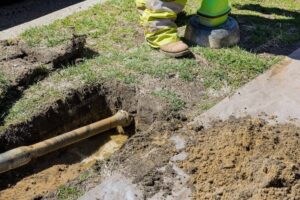Preserving historical buildings is a responsibility we owe to future generations. Trenchless pipe repair offers a promising solution to the challenges of maintaining these treasures from the past.
Historical buildings are more than just architectural marvels. They are windows to the past, reflecting the craftsmanship and culture of their time. These structures hold stories, memories, and traditions that are invaluable to our heritage.
However, preserving historical buildings poses a unique set of challenges, particularly when it comes to repairs and renovations. Traditional methods can often harm the structural integrity and historical significance of these buildings.
In this blog, we will explore the challenges of repairing historical structures, delve into trenchless methods for historical building preservation, discuss the delicate balance between restoration and conservation, showcase success stories of trenchless repairs in heritage sites, and emphasize the importance of collaborating with preservation
Challenges of Repairing Historical Structures
Repairing historical buildings is a daunting task, mainly due to the delicate balance that must be struck between maintaining their historical integrity and ensuring their safety for future generations. Here are some of the primary challenges faced in this endeavor:
- Preservation vs. Modernization: One of the biggest dilemmas is whether to preserve a historical building as it is or adapt it to modern needs. Stripping away its historical features for contemporary conveniences can compromise its cultural significance.
- Structural Integrity: Many historical buildings suffer from structural issues such as foundation problems, cracks, and deterioration. Traditional repair methods might exacerbate these problems, leading to irreversible damage.
- Material Matching: Finding materials that match the original ones used in construction can be a challenge. Mismatched materials can affect the building’s aesthetics and longevity.
Trenchless Pipe Repair for Historical Building Preservation
When it comes to the preservation of historical buildings, the choice between traditional and trenchless pipe repair methods is pivotal.
Traditional repair methods, while effective in their own right, often require extensive excavation, which can be especially problematic in historical contexts. The act of digging up the surroundings and potentially compromising the building’s foundation can lead to unforeseen structural damage and add significant costs to the restoration process.
On the other hand, trenchless pipe repair offers a more delicate touch. It is minimally invasive, preserving the historical integrity of the building while addressing plumbing or sewer line issues. This method reduces the disruption to the surrounding environment and contributes to cost savings by minimizing the need for extensive restoration work.
Thus, trenchless pipe repair offers a viable solution to the challenges of historical building preservation. It protects the physical structure of historical buildings and safeguards their cultural significance.
By avoiding extensive excavation and preserving the building’s original features, trenchless techniques ensure that the stories and memories held within these architectural treasures remain intact, enriching our understanding of the past. Here are some trenchless methods commonly employed:
- Pipe Bursting: In cases where plumbing or sewer lines need replacement, pipe bursting allows for the installation of new pipes without digging up the entire area. This minimizes disruption to the building and its surroundings.
- Horizontal Directional Drilling (HDD): HDD is a trenchless method used for laying utility lines, including water and gas pipelines. It involves drilling horizontally underground, avoiding disruption to the surface.
- Cured-in-Place Pipe (CIPP): CIPP is a non-invasive technique for rehabilitating aging or damaged pipelines. It involves the insertion of a resin-coated liner into the existing pipe, which hardens to form a new, durable pipe within the old one.
Balancing Restoration and Conservation
Preserving historical buildings through trenchless repair involves a delicate balancing act between restoration and conservation. Restoration aims to return the building to its original condition, while conservation seeks to protect and maintain its historical value. Achieving this balance is crucial to ensuring that the building remains a living testament to the past while still serving modern needs.
Success Stories: Trenchless Repairs in Heritage Sites
Several success stories highlight the effectiveness of trenchless repairs in preserving historical buildings. These examples showcase how trenchless methods can address complex issues while safeguarding a building’s historical character:
- The Louvre Museum, Paris: The Louvre, a historic masterpiece, faced drainage issues due to aging sewer lines. Trenchless methods were used to replace the old pipes without excavating the courtyard, preserving the museum’s iconic appearance.
- Independence Hall, Philadelphia: Independence Hall, a symbol of American history, needed sewer line repairs. Trenchless technology was employed to replace the damaged pipes while safeguarding the building’s structural integrity.
Collaborating with Preservation Experts
Preserving historical buildings with trenchless repair requires collaboration between skilled plumbers and preservation experts. Preservation experts understand the historical and cultural significance of the building, ensuring that any repairs or renovations align with preservation goals.
This collaboration ensures the building’s integrity is maintained while addressing necessary repairs. By carefully balancing restoration and conservation, employing trenchless methods, and collaborating with preservation experts, we can ensure that our historical buildings continue to stand as living testaments to our shared heritage.
If you own or are responsible for the upkeep of a historical building, consider the benefits of trenchless repair methods. Reach out to preservation experts and experienced plumbers who can help you navigate the complexities of historical building preservation.
Conclusion
Non-invasive methods like trenchless pipe repair and trenchless sewer repair provide a modern solution to an age-old challenge. They allow us to safeguard our historical treasures without sacrificing their authenticity, ensuring that these architectural marvels continue to stand the test of time.
By taking proactive steps, you can contribute to the preservation of our rich cultural heritage and ensure that these architectural gems continue to inspire and educate future generations. Smelscer Plumbing is here to assist you in this important endeavor. Contact us and let’s work together to preserve our historical treasures for generations to come.



